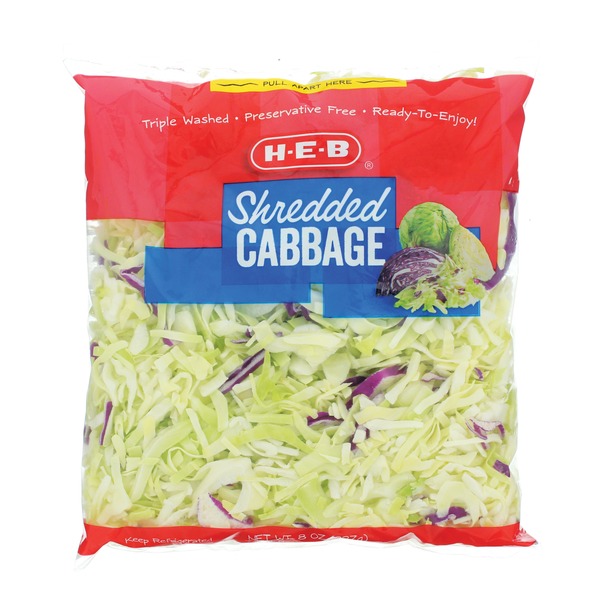Cabbage
Cabbage is a leafy green or purple biennial vegetable from the Brassica oleracea family, a versatile and nutrient-packed cruciferous vegetable cultivated worldwide. It is available in different varieties such as green, red, savoy, and napa, each with its distinct taste and texture. Cabbage is rich in vitamins C and K, and it is an excellent source of dietary fiber, making it a valued addition to a healthy diet.
Historically, cabbage has been consumed for centuries and is a popular ingredient in various cuisines. It is commonly used in dishes such as coleslaw, sauerkraut, salads, and in the preparation of stuffed rolls, soups, and stir-fries. Its mild flavor and adaptability make it easy to incorporate into numerous recipes.
81%
CARBS
1%
FAT
18%
PROTEIN
1,343 Cabbage Products
Margaret Holmes Cabbage Seasoned
H-E-B Shredded Cabbage
Glory Foods Seasoned Southern Style Country Cabbage
Green Cabbage
Cabbage
ORG CABBAGE
Josie's Organics Cabbage & Carrots Mix
CABBAGE RED (MI) RPC
White Cabbage & Carrots With Scallions And Grilled Onions, Lightly Seasoned With Salt And Black Pepper Shredded Veggies, White Cabbage & Carrots
Cabbage
Used In 5,486 Recipes
4
Ultimate Chicken Chow Mein
2
Quick & Flavorful Cabbage Roll Skillet
2
Easy One-Pot Cabbage Roll Bowl
4
Flavorful Chicken and Cabbage Stir Fry
5
Savory Unwrapped Egg Roll Bowl
4
Savory Deconstructed Egg Roll Bowl
3
Savory Brazilian Burrito Bowls
3
Sweet & Savory Chicken Veggie Rice Bowl
Cabbage Is Frequently Used With
Cabbage FAQ
Cooking with cabbage isn't difficult but knowing a few tips and tricks can improve your kitchen skills vastly. One of the most common mistakes when cooking cabbage is overcooking it, which can leave it soggy and devoid of its essential nutrients. The secret to perfectly cooked cabbage is timing, whether you're sautéing, boiling, or steaming it. Another error is not washing it thoroughly enough. Cabbage often contains dirt and insects between layers, so it's crucial to clean them properly. To get the most flavor out of cabbage, try cooking it with strong spices and herbs. Also, if you want to cut cabbage without tears, chill it in the refrigerator before chopping. Lastly, the hearts of cabbages are edible and they add an interesting texture twist to your dishes.
Why does my cabbage turn blue during cooking?
How can I prevent my cabbage from smelling during cooking?
Is it necessary to remove the outer leaves of the cabbage?
Can I eat cabbage raw?
Do different kinds of cabbage have different flavors?
How do I make cabbage less bitter?
How can I reduce gas after eating cabbage?
Why does cabbage get mushy when cooked?
How can I cut a cabbage easily?
Can I freeze cabbage?
Expiration & Storage Tips
When does cabbage expire?
Unopened and kept in the vegetable crisper of the fridge, a head of cabbage can last between two to three weeks, sometimes even a month depending on its freshness when purchased. Once it has been cut, it tends to quickly lose its crispness and may last about 1-2 weeks in the refrigerator, so it's best to use it within this time frame. If the cabbage is cooked, consume it within 3-4 days for the best quality. You can also freeze cooked or blanched cabbage for up to 9-14 months.
How do you tell if cabbage is bad?
When cabbage has gone bad, it will show signs of discoloration, usually turning brown or black. It will also have a strong, unpleasant smell, and slimy or moldy patches may appear. The leaves may become limp, and the overall texture can change, losing its crunchiness. When you start to see these signs, it's best to discard the cabbage.
Tips for storing cabbage to extend shelf life
• Always store cabbage in a cool place such as the vegetable crisper of your refrigerator. A whole head of cabbage can be stored in a plastic bag to retain its moisture.
• For half or cut pieces, wrap them in plastic wrap and refrigerate.
• Avoid washing cabbage until just before using, to prevent speading bacteria and accelerating spoilage.
• Blanch and freeze cabbage for long-term storage. Freezing cabbage changes its texture, making it best for cooked dishes upon defrosting. To defrost, simply move it to the refrigerator section 24hours before use.
EXPIRES WITHIN
11 - 26
DAYS
Equivalents
Substitutes
Health Info
Macros
4g
CARBS
0g
FAT
0g
PROTEIN
Allowed on these diets
LOW FAT
VEGETARIAN
KETO
PALEO
WHOLE 30
MEDITERRANEAN
LOW CARB
VEGAN
LACTOSE FREE
GLUTEN FREE













































